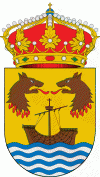Muxía
 |
Muxía is known for its beaches. It has an active fishing industry.
Muxía is part of the 'Costa da Morte' or 'Costa de la Muerte' (i.e., the "Coast of Death"). The Costa Da Morte was given this name because of the large number of shipwrecks along its rocky shore. The Costa Da Morte is one of the three regions of the Costa del Marisco, or "The Seafood Coast."
Muxía is 3 kilometers from a famous Benedictine monastery that is now used as a church, the Church of San Xulián de Moraime. The name of the town, "Muxía", refers to the monks who established this monastery. Another famous church in the area is the Santuario da Virxe da Barca which stands on a rocky ridge above the surf.
There are several locations along the Costa da Morte that have a "pedra de abalar", (i.e., an "oscillating stone"), or rocking stone. One of these is in Muxía, the "Pedra da Barca". These are large stones that are balanced on a point, so that they can be moved back and forth easily, or even wiggle in response to the wind. These were used at one time to determine the guilt or innocence of those accused of serious crimes.
There was a serious oil spill involving the oil tanker "Prestige" along the Muxía part of the coast in November, 2002, leaking about 70,000 gallons of oil into the Atlantic.
In the 5th century and 6th century, Galicia was part of the Germanic Suevi kingdom. The Moors replaced the Germanic rulers, who were displaced in the 8th or 9th century by the king of Asturias.
The monastery near Muxía was named "Mosteiro de Moraime" to honor the saint, San Xiao de Moraime, and was established in the early 12th century. Not long after, in 1105, it was attacked and destroyed by Norman pirates, and later by Saxons. Alfonso Raimúndez, the future King and Emperor Alfonso VII of León and Castile, had lived in the area when he was younger and was educated by Pedro Froilaz de Traba. Although he was only 14 at the time, Alfonso restored the monastery with a donation in 1119.
The nearby church dedicated to "Nosa Senora da Barca", the "Santuario da Virxe da Barca" was originally a pre-Christian Celtic shrine and sacred spot. This part of Spain was resistant to conversion to Christianity, and was only converted in the 12th century. The Christians built a hermitage on this location at first, and later the present church in the 17th century. On December 25, 2013, the Santuario da Virxe da Barca was destroyed by a fire caused by lightning.
Legend has it that St. James the Greater was trying to Christianize the local inhabitants and was having no luck and was discouraged. The Virgin Mary appeared to St. James to comfort him. The Celtic stones near the church are now said to be remains of the Virgin Mary's stone boat.
Map - Muxía
Map
Country - Spain
 |
 |
| Flag of Spain | |
Anatomically modern humans first arrived in the Iberian Peninsula around 42,000 years ago. The ancient Iberian and Celtic tribes, along with other pre-Roman peoples, dwelled the territory maintaining contacts with foreign Mediterranean cultures. The Roman conquest and colonization of the peninsula (Hispania) ensued, bringing the Romanization of the population. Receding of Western Roman imperial authority ushered in the migration of different non-Roman peoples from Central and Northern Europe with the Visigoths as the dominant power in the peninsula by the fifth century. In the early eighth century, most of the peninsula was conquered by the Umayyad Caliphate, and during early Islamic rule, Al-Andalus became a dominant peninsular power centered in Córdoba. Several Christian kingdoms emerged in Northern Iberia, chief among them León, Castile, Aragon, Portugal, and Navarre made an intermittent southward military expansion, known as Reconquista, repelling the Islamic rule in Iberia, which culminated with the Christian seizure of the Emirate of Granada in 1492. Jews and Muslims were forced to choose between conversion to Catholicism or expulsion, and eventually the converts were expelled through different royal decrees.
Currency / Language
| ISO | Currency | Symbol | Significant figures |
|---|---|---|---|
| EUR | Euro | € | 2 |
| ISO | Language |
|---|---|
| EU | Basque language |
| CA | Catalan language |
| GL | Galician language |
| OC | Occitan language |
| ES | Spanish language |















